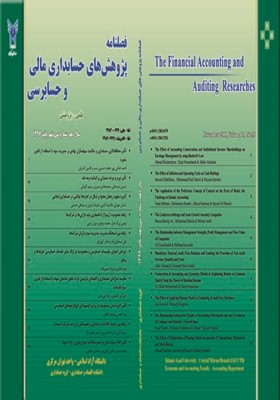شناسایی سازههای مؤثر در جذب بدهی
محورهای موضوعی : حسابداری مالی و حسابرسیسعید جبار زاده کنگر لویی 1 * , انور بایزیدی 2 , امجد رحمان زاده 3
1 - استادیار دانشگاه ازاد اسلامی واحد ارومیه
2 - کارشناس ارشد حسابداری دانشگاه شیراز
3 - کارشناس ارشد حسابداری دانشگاه ازاد اسلامی واحد تبریز
کلید واژه:
چکیده مقاله :
هدف این پژوهش شناسایی و معرفی سازههای مؤثر در تأمین مالی از طریق بدهی در شرکتهای پذیرفته شده در بورس اوراق بهادار تهران میباشد. دوره زمانی پژوهش، 1387-1382 بوده و 360 سال-شرکت بهعنوان نمونه انتخاب شده است. برای تجزیه و تحلیل دادههای پژوهش در حالت تلفیقی(تجمعی)، از مدلهای رگرسیونی چند متغیره با اثرات ثابت در نرمافزار اقتصادسنجی EViews 6 استفاده شده است. در این پژوهش، اهرم مالی کل بدهی بر کل دارایی بهعنوان متغیر وابسته و درصد مالکیت نهادی بهعنوان متغیر مستقل و از متغیرهای کنترلی مؤثر بر جذب بدهی شامل سود نقدی سهام، سودآوری، ریسک تجاری، ساختار داراییها، نقدینگی، رشد و اندازه شرکت نیز استفاده شده است. نتایج نشان میدهد که بین جذب بدهی و درصد مالکیت نهادی رابطهای وجود ندارد و با وارد کردن متغیرهای کنترلی در مدل رگرسیونی، قدرت توضیحی مدل از 27% به 46% افزایش مییابد. همچنین نتایج نشان میدهد که در طی دوره پژوهش متغیرهای سودآوری، ریسک تجاری، ساختار دارایی، نقدینگی، نرخ رشد و اندازه شرکت از عوامل مؤثر بر جذب بدهی شرکت بودهاند. لازم به ذکر است که در بین متغیرهای پژوهش، متغیر ریسک تجاری در طی دوره پژوهش، با توجه به بالا بودن ضریب رگرسیونی آن در مقایسه با سایر متغیرها، دارای بیشترین تأثیر بر روی جذب بدهی بوده است
The aim of this research is to introduce of effective factors in financing by liabilities in listed companies in Tehran Stock Exchange. Time period of the research is 2003-2008 and it’s been ed 360 firm-years as sample. To analyze of research data in pooled status were used multiple regression models with fixed effect in econometric software EViews 6. In this research, Debt structure (financial leverage of total liabilities to total assets) was applied as dependent variables and percentage of institutional ownership as independent variable, and it’s used effective control variables on liabilities structure such as dividend pay out ratio, profitability, business risk, assets structure, liquidity, growth rate (market-to-book ratio) and company size, too. Findings show that there isn’t relation between liability absorption and percentage of institutional ownership; however, with entering control variables to regression model, explanatory power of it increases 27% to 46%. The results too indicate that profitability, business risk, assets structure, liquidity, growth rate and size of firm have been effective factors on liability absorption during research period. It should be mentioned that among research variables, business risk variable has had the highest effect on liability absorption based on its high regression coefficient in comparing to other variables.

